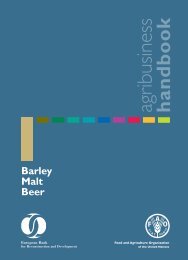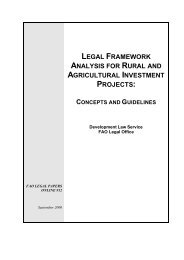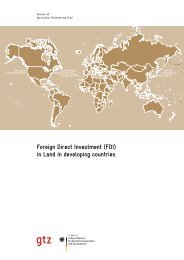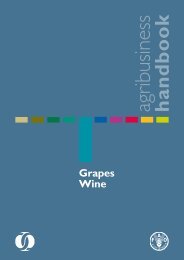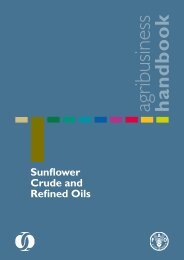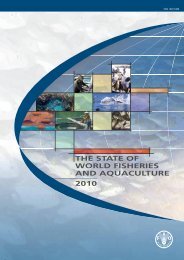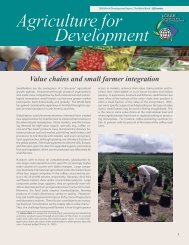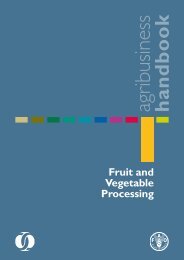Agribusiness Handbook: Milk / Dairy Products - FAO
Agribusiness Handbook: Milk / Dairy Products - FAO
Agribusiness Handbook: Milk / Dairy Products - FAO
Create successful ePaper yourself
Turn your PDF publications into a flip-book with our unique Google optimized e-Paper software.
Table 2: <strong>Milk</strong>ing animals and yields, 2007<br />
Species M head Kg/year a<br />
Cow 245.08 2,287<br />
Buffalo 57.52 1,485<br />
Goat 170.07 87<br />
Sheep 195.36 47<br />
Camel 4.28 345<br />
Total 672.31 1,000<br />
a - 10 Nov quotation.<br />
Source: International Grains Council Grain Market Indicators, November 2008<br />
The quantity of milk (yield) produced in a year by an animal varies enormously<br />
according to breed, feed and management practices. The world average of<br />
2,300 kg/year per cow is somewhat meaningless because it is influenced<br />
heavily by the large numbers of poor-yielding animals in less developed<br />
countries across the globe. In many developed dairying countries, yields are<br />
typically 4,000–5,000 kg/head and exceptionally reach 6,000–8,000 kg/head<br />
in particular intensively managed enterprises. In such systems, cows will be<br />
selected on the basis of yield, the calving interval will be closely monitored<br />
(cows produce milk only when they have been put in calf), inseminations will<br />
be with bulls with high-yielding daughters (rather than having cows served<br />
by a local bull, for example), the animals will have their feeding rations and<br />
regime controlled, probably by computer, and they may be milked three times<br />
a day. The cows will produce significant volumes of milk, but will be kept for<br />
only a small number of lactations, maybe four or five. After this, the animals<br />
will be culled.<br />
The structure of dairy farming varies enormously from country to country.<br />
In many developing countries, the owner of the holding has just one cow,<br />
while in commercial dairying enterprises the worldwide average herd size is<br />
typically more than 100 animals – in the United States, many Californian herds<br />
have more than 1,000 animals. About 90% of California’s milk is produced<br />
in herds of more than 500 animals. Within the European Union (EU), there<br />
is a vast difference between the structure of dairying in a country such as<br />
the Netherlands and the dairy industries in Baltic countries, for example. In<br />
the former, the majority of herds consist in more than 100 animals and the<br />
average herd size is 60 animals per holding. In a country such as Lithuania,<br />
the average size of a dairy holding is five cows, and only 28% of animals are<br />
in herds of more than 50 cows.<br />
8



